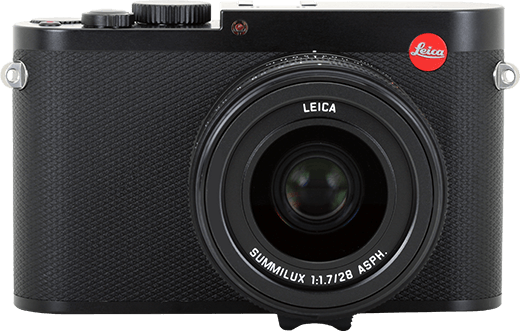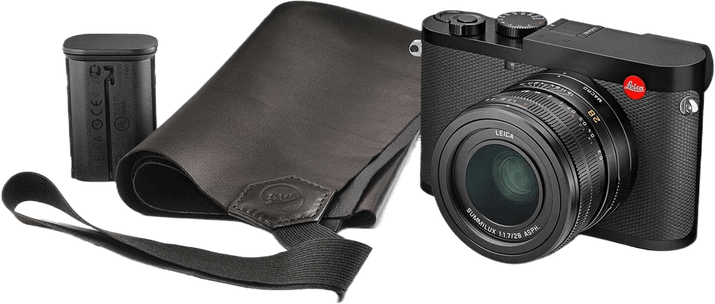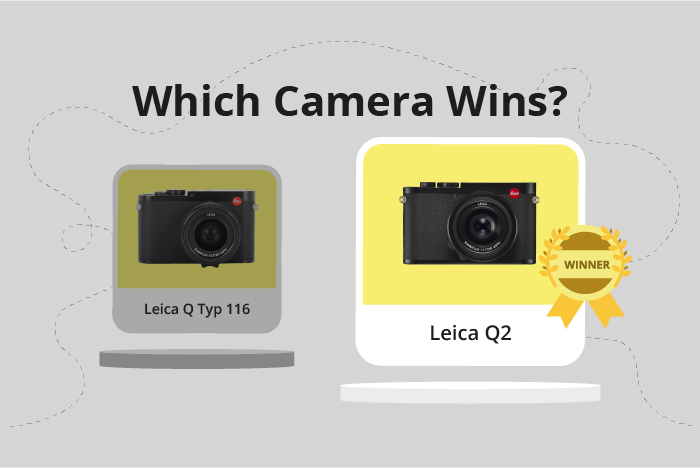Leica Q Typ 116 vs Q2 Comparison
Leica Q Typ 116

Leica Q2

The Leica Q2 outperforms the Leica Q Typ 116 with a score of 76/100 compared to 64/100. Both cameras share the compact category, similar dimensions (130 x 80 x 93mm for Typ 116 and 130 x 80 x 92mm for Q2), and high launch prices ($4250 for Typ 116 and $5000 for Q2).
The Q2 excels with its higher score, which reflects its superior performance and features. However, the Q Typ 116 has a slight advantage in weight, being lighter at 640g compared to the Q2’s 734g, which could be beneficial for users prioritizing portability.
In terms of specifications and performance, the Leica Q2 is the clear winner. Nonetheless, the Leica Q Typ 116 might appeal to those who prefer a more lightweight option and can accept its lower score.
Leica Q Typ 116 vs Q2 Overview and Optics
The Leica Q2 outperforms the Leica Q Typ 116 in optics with a score of 79/100 compared to 72/100. Both cameras share several common specifications, such as a CMOS sensor, Maestro II processor, full-frame sensor size, fixed lens mount, and the absence of image stabilization. They also have the same shooting speed of 10 frames per second.
The Q2’s superiority is mainly due to its higher megapixel count at 47.3, compared to the Q Typ 116’s 24.2 megapixels. This difference allows the Q2 to capture more detail and produce higher resolution images. Additionally, the Q2’s sensor has a higher DXOMARK score of 96, compared to the Q Typ 116’s score of 85. The higher score signifies the Q2’s better overall sensor performance, including dynamic range, color depth, and low-light capabilities.
Despite the Q Typ 116’s lower score, it still has some advantages. The lower megapixel count can result in faster image processing times and smaller file sizes, which may be beneficial for certain users. However, it is important to note that the Q2 retains the same shooting speed as the Q Typ 116, so the difference in processing times may not be significant.
Taking these factors into account, the Leica Q2 is the clear winner in terms of optics, providing better image quality and sensor performance. The Q Typ 116 may still be suitable for users who prioritize smaller file sizes and faster processing, but the Q2’s improvements make it the better choice for those seeking superior image quality.
Leica Q Typ 116 vs Q2 Video Performance
The Leica Q2 outperforms the Leica Q Typ 116 in terms of video capabilities, scoring 91/100 compared to the Leica Q Typ 116’s score of 70/100. Both cameras share some common features, such as built-in time-lapse functionality. However, the Leica Q2 surpasses the Leica Q Typ 116 in several key aspects.
The Leica Q2 offers a significantly higher maximum video resolution of 4K, with dimensions of 4096 x 2160 pixels. This is a considerable improvement over the Leica Q Typ 116’s Full HD resolution of 1920 x 1080 pixels. The increased resolution enables the Leica Q2 to capture much more detail and produce higher-quality video footage.
Additionally, the Leica Q2 boasts a maximum video frame rate of 120fps, which is twice the frame rate of the Leica Q Typ 116’s 60fps. The higher frame rate allows for smoother video playback and the possibility of slow-motion effects in post-production, providing more creative options for users.
The Leica Q Typ 116 does not offer any advantages over the Leica Q2 in terms of video capabilities. Its lower video resolution and frame rate make it less suitable for professional videography or users seeking the best possible video quality from their camera.
Taking these factors into account, it is clear that the Leica Q2 is the superior choice for video capabilities. With its higher video resolution and frame rate, the Leica Q2 effortlessly outshines the Leica Q Typ 116, making it the ideal choice for those who prioritize video quality and performance in their camera selection.
Leica Q Typ 116 vs Q2 Features and Benefits
The Leica Q2 emerges as the winner in the comparison of features, with a score of 83/100, while the Leica Q Typ 116 scores 57/100. Both cameras share some specifications, including a 3-inch screen size, a screen resolution of 1040000 dots, a touchscreen, and the absence of a flip screen and GPS.
The Leica Q2 excels with its additional features of WIFI and Bluetooth, which are not present in the Leica Q Typ 116. These wireless connectivity options allow for easier sharing and transfer of photos, as well as remote control of the camera through compatible devices. This makes the Q2 more versatile and convenient for photographers who require seamless connectivity.
On the other hand, the Leica Q Typ 116 does not have any notable advantages over the Q2 in terms of features. Both cameras share the same screen specifications and lack of flip screen and GPS. The absence of WIFI and Bluetooth in the Typ 116 limits its connectivity options compared to the Q2.
Taking these factors into account, it is clear that the Leica Q2 is the superior camera in terms of features, offering greater convenience and versatility with its wireless connectivity options. The Leica Q Typ 116, while sharing some specifications with the Q2, falls short due to its lack of WIFI and Bluetooth. Therefore, photographers seeking a camera with more advanced features should opt for the Leica Q2.
Leica Q Typ 116 vs Q2 Storage and Battery
The Leica Q2 wins in storage and battery with a score of 21/100, while the Leica Q Typ 116 scores 16/100. Both cameras have one memory card slot and accept SD, SDHC, and SDXC cards. The Leica Q2 outperforms the Leica Q Typ 116 in battery life, offering 350 shots compared to the Leica Q Typ 116’s 300 shots. The Q2 uses a BP-SCL4 battery, while the Q Typ 116 uses a BP-DC12 battery. Neither camera has USB charging.
Despite the lower score, the Leica Q Typ 116 still provides a decent battery life and storage options. However, the Leica Q2’s extended battery life makes it a more reliable choice for extended shooting sessions. In terms of storage and battery, the Leica Q2 stands as the more advantageous option.
Leica Q Typ 116 vs Q2 – Our Verdict
Are you still undecided about which camera is right for you? Have a look at these popular comparisons that feature the Leica Q Typ 116 or the Leica Q2:

